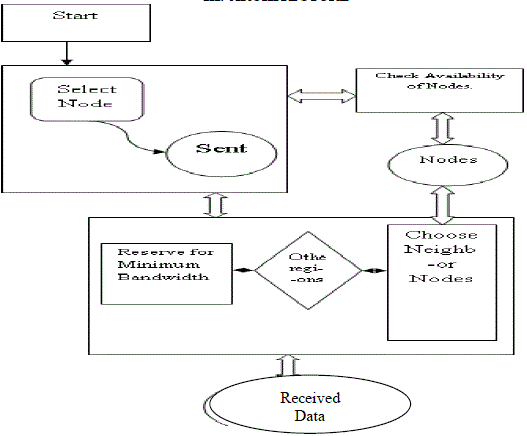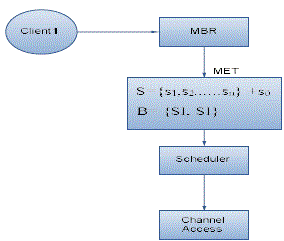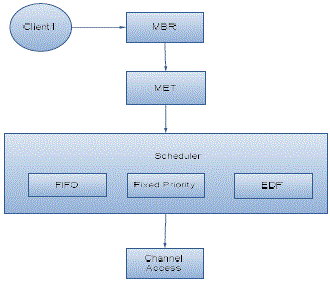Keywords
|
| Wireless Local Area Network (WLAN), Quality of Service, Generic algorithm, Fixed Priority, Earliest Deadline First (EDF), First In First Out (FIFO), Base Station (BS), Service Interval (SI), Service Period (SP) |
INTRODUCTION
|
| The contention free transmission is the basic requirement for the periodic streams in real time systems. Here CSMA/CA Carrier Sense Multiple Access/ Collision Avoidance is supported by WLAN to avoid collision of packets. For managing the Reservation-based requires desired channel access duration for a given period to meet the traffic constraints. Therefore it will result in poor real time support, less scalability and exact resource determination which in turn leads to more computational complexities. The works aims in providing two solutions for exclusive channel access for each node |
| 1) Based on the three scheduling polices such as Fixed priority, First In First Out, Earliest Deadline First the real time constraints can be solved. |
| 2) Minimization of bandwidth reservation. |
| The bandwidth reservation per channel access period is equal to the sleep time of the sleep stream with period equal to the channel access period. This is to solve the minimum bandwidth reservation problem at a given node. This describes minimum channel access is proportional to maximum sleep time. To form the extended stream set, the original stream is added with the sleep stream. Thus the scheduling policy for original stream is also extended based on extended stream. |
| 1) The priority relationship between the extended stream original streams set is unchanged. |
| 2) The sleep stream always has the highest priority. |
| To solve this effect, the minimum bandwidth reservation problem is changed to the maximum sleep time problem. Shortly it can said that if there exist the schedule for the original stream using scheduling policy then the extended stream set using the extended scheduling policy is possible. 1.2 System Analysis |
| Based on IEEE 802.11e protocol a wireless standard provide channel access reservations. The IEEE 802.11e standard proposes a Hybrid Coordination (HCF) that in turn provides both contention-free and contention-based channel accesses. It provide the channel access based on two modes |
| 1) Enhanced Distributed Channel Access (EDCA) |
| 2) HCF Controlled Channel Access (HCCA) |
| Continuous polling is done by the Central Authority, with HCCA, the Hybrid Coordinator (HC) which is based on IEEE 802.11e protocol which provides energy efficiency and reserve the bandwidth minimally. |
LITERATURE SURVEY
|
Wireless Channel Access Reservation for Embedded Real-Time Systems
|
| The goal of the work is to develop a strategy for the computation of channel access reservation parameters such that the resource reservations are minimized and the real-time constraints of each node's traffic are satisfied. The proposed formulations prevent a node from negotiating a greater share of the channel resources than is actually required. This provides better scalability and also it prevents these resources from being over provisioned. |
| In addition, the packet transmission deadlines that describe the timeliness requirements of the traffic are studied. The greatest impact on resource reservations is investigated. Such analysis is especially useful during system and application design. The range of feasible packet deadlines can be identified from the timeliness constraints and by the actual deadline which it meets. The actual deadline is given in terms of resource requirements. They can then be chosen by considering its consequences. |
| The contributions of this work are identification and formulation of the minimum worst case values for the channel access reservation parameters at each node. To meet the real-time requirements of its traffic and for the investigation of packet deadline assignment strategies are guaranteed. This leads to the conclusion that increasing a packet deadline does not always lower resource requirements and the development of guidelines for their assignment if such edibility exists. The managed networks (as opposed to ad-hoc networks), where each node connected to a wireless base station (BS). This executes the proposed computation of required channel access parameters. Such an approach not only achieves more efficient utilization of channel resources and reduces the overheads of the BS an. Moreover, this work can also complement existing mechanisms at the BS. Such work is implemented to address the computation of reservation parameters at individual nodes (as opposed to the BS) in wireless real-time environments. |
| The advantages of reservation-based channel access are given in two folds |
| 1) To meet timing constraints predictably they provide contention-free channel access within allocated/ reserved channel access intervals. |
| 2) They allow a wireless radio to be powered down when the channel is not needed. |
| A resource allocation which is done carelessly may lead to poor support for over-provisioning of scarce network resources or real-time traffic. This paper solves the minimum bandwidth reservation problem to allow all streams to meet their timing constraints. To obtain a solution to the minimum bandwidth reservation problem based on timedemand analysis transform it to a generic uniprocessor task schedulability problem. The generic uniprocessor task schedulability problem is then addressed using a generic algorithm. |
Medium Access Control with Coordinated Adaptive Sleeping for Wireless Sensor Networks
|
| This paper describes about the design of a good MAC protocol for the wireless sensor networks have considered the following attributes. The first attribute to deal about is energy efficiency. As stated above, sensor nodes are likely to be battery powered on when it is in use. It is often very difficult to change or recharge batteries for these nodes. To make some of the nodes to be cheap enough, they are discarded rather than recharged. The main critical issue is prolonging network lifetime the nodes. Another important attributes are scalability and adaptively to changes in network size, node density and topology. Some nodes may join later or some new nodes die over time may or some nodes may move to different locations. A good MAC protocol should gracefully accommodate such network changes. Other typically important attributes including fairness, latency, throughput, and bandwidth utilization may be secondary in sensor networks. The paper presents sensor-MAC (S-MAC), a MAC protocol explicitly designed for wireless sensor networks. While reducing energy consumption is the primary goal in design, S-MAC also achieves good scalability and collision avoidance by utilizing a combined scheduling and contention scheme. |
| To achieve the primary goal of energy efficiency, identify what are the main sources that cause inefficient use of energy as well as what tradeoffs to reduce energy consumption. To demonstrate the effectiveness and measure the performance of S-MAC, This has been implemented it on test bed of wireless sensor nodes, Motes,1 developed by the University of California, Berkeley, and manufactured by Crossbow Technology, Inc.2 The mote runs on a very small event-driven operating system called Tinos. This is evaluated in S-MAC design tradeoffs on this platform. The contributions of this paper are as follows. The implemented low-duty-cycle scheme in multichip networks that significantly reduces energy consumption by avoiding idle listening. A demonstrated technique of adaptive listening that greatly reduces the latency caused by periodic sleeping. Applying message passing to reduce application-perceived latency and control overhead. Experimental measurement and evaluation of S-MAC performance on energy, latency and throughput over sensor-net hardware. |
Approximate Bandwidth Allocation for Compositional Real-Time Systems
|
| This paper describes about the Component-based design is widely practiced in system design and development due to the remarkable benefits obtained from decomposing a complex system into simpler components. Component abstraction, a central goal of component-based design, permits each component to hide internal complexity and details from developers of other components and only exposes information necessary to use the component via an interface. Recently, component-based design for real-time systems has received considerable attention, as numerous frameworks for compositional real-time systems have been proposed. Most real-time compositional frameworks provide a real-time interface through which a component may express its temporal requirements (e.g., processing time requirements and deadlines). An important attribute of a real-time interface is the interface bandwidth. The interface bandwidth simultaneously quantifies the fraction of the total system resource supply that a component C will require to meet its real-time constraints and the component C’s “interference” on the resource supply provided to other system components. |
Resource Partition for Real-time Systems
|
| This paper describes about the resource partition. For the implementation of resource partition, the temporal resource partitions are carried out. The temporal resource partition says about the entire resource. As a result of implementing the temporal resource partition the Timing constraints may share the same physical resource. Due to sharing of the same physical resource less interference only occur. To add the flavor the partition uses only a fraction of the time. |
| There are two reasons for the open system consideration they are |
| 1) Resource sharing is more economical than the dedicated resources. |
| 2) In case of hardware failure an open system environment would allow task group to be relocated by coexisting with other task group on diminished pool of shared resources. |
| Two models are implemented in the resource partition. |
| 1) Static partition |
| 2) Bounded delay |
| The temporal partition is a collection of time intervals during which physical resource is made available to the task group being scheduled on the partition. The investigation of the problem is based on scheduling task group for the given partition whose time intervals are explicitly specified in the list. Static partition which states fixed partition. By making use of technique of supply function the analyzing of fixed and priority schedulers with respect to the partition model. Bounded-delay partition which states the delay in resource partition. This will give clean separation between task group level scheduling and resource level partition scheduling. Two types of priority are taken into account. They are |
| 1) Fixed priority scheduling |
| 2) Dynamic priority scheduling |
| Therefore the resource partition for real time systems will lead to less interference even though the high complexity will occur in resource partition. |
A Survey of Energy-Efficient Scheduling Mechanisms in Sensor Networks
|
| This paper describes about the energy efficiency. Sensor networks have a wide range of potential, practical and useful applications. However, there are issues that need to be addressed for efficient operation of sensor network systems in real applications. The energy saving is one of the critical issue in sensor networks. To extend the lifetime, dynamically schedule the sensors work/sleep cycles. In cluster-based networks, cluster heads are selected to minimize the total energy consumption. The energy-efficient scheduling mechanisms need to satisfy certain application requirements while saving energy. Different mechanisms may make different assumptions about their sensors including detection model, sensing area, transmission range, failure model, time synchronization, and the ability to obtain location and distance information. They may also have different assumptions about network structure and sensor deployment strategy. |
Generic Algorithm
|
| The Maximum Execution Time (MET) problem, is based on an augmented time-demand analysis. According to the following description, the generic algorithm distinguishes between the finished portion and the unfinished portion of execution before a given deadline. This concept allows us to conservatively reduce the sleep time of the sleep stream to approach its minimum value. By assuming that the reduced sleep time (equal to the unfinished portion) is solely utilized by the job missing its deadline. A generic time-demand function is defined at every job release event point to compute the finished/unfinished portions of a job. The dedicated time supply minus the generic time demand is equal to the available time at a job release event point for lower priority jobs. As a result of this, the finished portion of a job before its deadline is equal to the maximum available time over all job release event points between its release time and its deadline. This is clearly understandable that it has not yet finished. And therefore if appropriate scheduling policies and stream parameters are selected for a given stream set the proposed bandwidth reservation scheme leads to minimal amounts of bandwidth waste. However, it also leads to potentially large energy savings and simple to implement and deploy. |
| 1. First sleep stream execution time ( ) is initialized to the maximum value since the goal is to minimize bandwidth overreservation for S'. |
| 2. Scan every job in increasing order of release times or deadlines in the busy interval time period. |
| 3. For each job compute the finished portion, unfinished portion and the completion time i , j. |
| 4. If unfinished portion >0 means decrement the execution time of S0. |
| 5. Otherwise abort when it is impossible to meet the job’s deadline even if the node were allocated the entire bandwidth (i.e., SP=SI). |
| 6. If<0 means abort the job. |
| 7. Determine if the synchronous busy interval is terminated or whether it is impossible to meet the job’s deadline even if the Nodes were allocated the entire bandwidth. |
| 8. If overall completion time i.e. v(fi,j)≤fj is satisfied, move on to check next job and perform the same steps for all the jobs. This framework scans every client within the synchronous busy interval to check if it meets its deadline. The timeliness checks of the clients of S0, referred to as sleep clients in the remainder of the paper, are temporarily skipped until the synchronous busy interval ends. Consider the execution of each client to be divided into two distinct portions: the finished portion and the unfinished portion before the deadline. If client misses its deadline, the execution time will be reduced such that the total amount of reduced execution times of all sleep clients before is equal to. |
PROBLEM FORMULATION
|
|
|
Existing System
|
|
| Wireless embedded real-time systems are becoming widespread with the continuous increase in streaming applications such as video communications, audio communications, industrial automation, wireless sensor networks, actuator networks, networked systems, and embedded control systems. This is to enhance the timeliness and support the Quality of Service (QoS) in wirelessly networked embedded environments. Wireless networks are naturally broadcast and media-shared. Contention-based media accesses such as CSMA are non-deterministic. It states that it is incapable of providing predictable QoS support to periodic communications. This is the major drawback often found in wireless real-time systems. Moreover, multiple nodes are active at all the time, continuously sense the other nodes for the packet transmission and compete for the shared media. These are some of the constraints which lead to excessive energy consumption. |
| Based on IEEE 802.11e protocol A wireless standard provide channel access reservations. The IEEE 802.11e standard proposes a Hybrid Coordination (HCF) that in turn provides both contention-free and contention-based channel accesses. Based on the two modes it provides the channel access. They are 1) Enhanced Distributed Channel Access (EDCA). 2) HCF Controlled Channel Access (HCCA). |
| The central authority (CA), continuously polls every node with HCCA, the Hybrid Coordinator (HC) which will provide energy efficiency and reserve the bandwidth minimally. Reservation-based channel management requires each node to negotiate its desired channel access duration for a given period based on its traffic constraints. However, the computation of such requirements has largely been ignored. Therefore it is often resulted in poor scalability, over provisioning of valuable resources and poor real-time support. The nodes reserves a continuous time interval (Static) for every individual node and nodes only wake up during their allocated intervals. And therefore it attains energy efficiency, but not maximally. |
Proposed System
|
| Reservation-based channel access protocols that explicitly allow wireless devices to negotiate channel access intervals have been receiving increasing attention. Such access mechanisms allow for contention-free and exclusive accesses. This resulted in providing deterministic bounds on the delays experienced by the traffic streams and conserving energy. Since wireless adaptors having no channel access can be temporarily powered down. |
| Therefore, for providing real-time services in wireless environments such access mechanisms are ideally suited. For example, in ad-hoc networks, coordinated sleep mechanisms have been designed to allow wireless devices to coordinate medium access with their neighbors and to reduce their energy requirements. Similarly, using protocols such as IEEE 802.11e, in infrastructure-based systems the wireless end devices can coordinate medium access with base stations (BSs). |
| The ultimate goal of this work is to develop a approach for the computation of the required channel access reservations for a given packet scheduling policy. Such that |
| 1) The real-time constraints of each node’s traffic are satisfied |
| 2) Resource reservations are minimized |
| Base Station (BS) chooses optimal Service Interval (SI) value. Service Interval (SI) is used by different client nodes which is a multiple of the beacon interval of the base station. The Reservations i.e. Service Period (SPs) of various nodes with different Service Intervals can be integrated and composed efficiently. |
MODULES
|
| 1. Minimum Bandwidth Reservation |
| 2. Maximum Execution Time |
| 3. Scheduler Module Descriptions |
Minimum Bandwidth Reservation
|
| The minimum Bandwidth reservation is represented as M. Given a node’s set S of periodic streams, a fixed service interval SI, and the node’s scheduling policy A, determine the minimum SP such that all streams in S meet their deadlines. |
 |
Maximum Execution Time
|
| First transform the scheduling model M = (S = {Si}n1 ,B = (SP, SI),A) of the MBR problem to another scheduling model M′ = (S′,B′,A′), where the stream set S′ extends S by adding a sleep stream; the scheduling policy A′ extends A by assigning the sleep stream the highest priority; and B′ represents the dedicated resource allocation for S′. To show that the two scheduling models are schedulable equivalent, i.e., M is schedulable if and only if M′ is schedulable. As a corollary, MBR problem in M is a dual of the maximum execution time problem of the sleep stream in M′. |
|
|
| S={si}n 1+s0 |
| B={SI,SI} |
| A’=Extended Scheduling Policy |
Scheduler
|
| The generic algorithm works for the periodic driven packet scheduling policies |
| 1. FIFO |
| 2. EDF |
| 3. Fixed Priority |
| 1) FIFO |
| In the First In First Out scheduling algorithm , only jobs released no later than job Ji,j have higher priority than Ji,j |
| 2) EDF |
| In the Earliest Deadline First scheduling algorithm, jobs with priorities higher than the priority of a job Ji,j are those whose deadlines are no later than di,j , and therefore they will be executed before di,j . |
| 3) Fixed Priority |
| The priority rule of a fixed-priority scheduling policy A is static at stream level, i.e., the second case of Equation 1 is not time-varying. Suppose that streams are indexed in the decreasing order of their priorities, i.e., stream Si has a higher priority than Sk if i < k. |
CONCLUSION
|
| Thus the paper concludes that the Base Station (BS) chooses optimal Service Interval (SI) value. Therefore this states that the nodes are powered on only if there is any need of the network. From this the nodes will achieve maximum energy efficiency. The better transmission is done in the way to provide the Quality of Service (QoS). Service Interval (SI) is used by different client nodes which is a multiple of the beacon interval of the base station. The Reservations i.e. Service Period (SPs) of various nodes with different Service Intervals can be integrated and composed efficiently. |
Figures at a glance
|
 |
 |
 |
 |
| Figure 1 |
Figure 2 |
Figure 3 |
Figure 4 |
|
References
|
- Jun Yi, Christian Poellabauer,Xiaobo Sharon Hu, and Liqiang Zhang, “Minimum Bandwidth Reservations for Periodic Streams in Wireless Real- Time Systems,” IEEE Transactions On Mobile Computing, vol. 10, no. 5, 2011.
- D. Rajan, C. Poellabauer, X.S. Hu, L. Zhang, and K. Otten,“Wireless Channel Access Reservation for Embedded Real-Time Systems,” Proc. Seventh ACM Int’l Conf. Embedded Software, pp. 129- 138, 2008.
- R.I. Davis, A. Zabos, and A. Burns, “Efficient Exact Schedulability Tests for Fixed Priority Real-Time Systems,” IEEE Trans. Computers, vol. 57, no. 9, pp. 1261-1276, Sept. 2008.
- T.L. Crenshaw, S. Hoke, A. Tirumala, and M. Caccamo, “Robust Implicit EDF: A Wireless MAC Protocol for Collaborative Realtime Systems,” ACM Trans. Embedded Computing Systems, vol. 6, no. 4, 2007.
- L. Wang and Y. Xiao, “A Survey of Energy-Efficient Scheduling Mechanisms in Sensor Networks,” Mobile Networks and Applications, vol. 11, no. 5, pp. 723-740, 2006.
- H. Hoang, G. Buttazzo, M. Jonsson, and S. Karlsson, “Computing the Minimum EDF Feasible Deadline in Periodic Systems,” Proc. 12th IEEE Int’l Conf. Embedded and Real-Time Computing Systems and Applications, pp. 125-134, 2006.
- IEEE 802.11e Standard, IEEE 802.11 WG, Part II: Wireless LAN Medium Access Control (MAC) and Physical Layer (PHY) Specifications: Medium Access Control (MAC) Enhancements for Quality of Service (QoS), Nov. 2005.
- O. Redell and M. Torngren, “Calculating Exact Worst Case Response Times for Static Priority Scheduled Tasks with Offsets and Jitter,” Proc. Eighth IEEE Real-Time and Embedded Technology and Applications Symp., pp. 164-172, 2002.
- A.K. Mok, X.A. Feng, and D. Chen, “Resource Partition for Realtime Systems,” Proc. Seventh IEEE Real-Time Technology and Applications Symp., pp. 75-84, 2001.
- J. Lehoczky, “Fixed Priority Scheduling of Periodic Task Sets with Arbitrary Deadlines,” Proc. 11th Real-Time Systems Symp., pp. 201-209, Dec. 1990.
- J. Regehr and J.A. Stankovic, “HLS: A Framework for Composing Soft Real-Time Schedulers,” Proc. 22nd IEEE Real-Time Systems Symp., pp. 3-14, Dec. 2001.
- IEEE 802.11 WG, Part II: Wireless LAN medium access control (MAC) and physical layer (PHY) specifications: Medium access control (MAC) enhancements for quality of service (QoS), IEEE 802.11e Standard, Nov 2005.
- ] X.A. Feng and A.K.Mok, A model of hierarchical real-time virtual resources, in Proceedings of the 23rd IEEE Real-Time Systems Symposium. Washington, DC, USA, IEEE Computer Society, 2002, p.26.
- A.K.Mok and X.A.Feng, Towards compositionality in realtime resource partitioning based on regularity bounds, in Proceedings of the 22nd IEEE Real-Time Systems Symposium. Washington, DC, USA, IEEE Computer Society, 2001, p. 129.
- J. W. S. Liu, Real-Time Systems. Upper Saddle River, NJ: Prentice Hall, 2001.
|